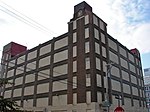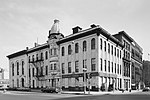Congregation Rodeph Shalom (Philadelphia)
1795 establishments in PennsylvaniaAshkenazi Jewish culture in PhiladelphiaDutch-Jewish culture in the United StatesGerman-Jewish culture in PennsylvaniaMoorish Revival architecture in Pennsylvania ... and 11 more
Moorish Revival synagoguesNational Register of Historic Places in PhiladelphiaPolish-Jewish culture in the United StatesPoplar, PhiladelphiaReform synagogues in PennsylvaniaReligious organizations established in 1795Synagogues completed in 1928Synagogues in PhiladelphiaSynagogues on the National Register of Historic Places in PennsylvaniaTourist attractions in PhiladelphiaYiddish culture in the United States

Congregation Rodeph Shalom of Philadelphia, founded in 1795, is the oldest Ashkenazic synagogue in the Western Hemisphere. It is noted historically for its leadership of the Reform Judaism among American Hebrew congregations, for its spiritual influence upon international Jewry, and for its unique 1927 Moorish Revival building on North Broad Street, on the National Register of Historic Places for many decades.
Excerpt from the Wikipedia article Congregation Rodeph Shalom (Philadelphia) (License: CC BY-SA 3.0, Authors, Images).Congregation Rodeph Shalom (Philadelphia)
Wallace Street, Philadelphia
Geographical coordinates (GPS) Address Nearby Places Show on map
Geographical coordinates (GPS)
| Latitude | Longitude |
|---|---|
| N 39.965277777778 ° | E -75.161111111111 ° |
Address
Wallace Street 1413
19130 Philadelphia
Pennsylvania, United States
Open on Google Maps









